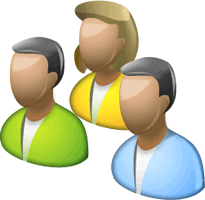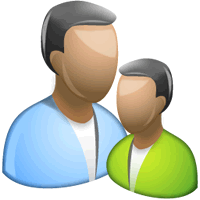
Scope and Sequence
Standard 1 ![]() Standard 2
Standard 2 ![]() Standard 3
Standard 3 ![]() Standard 4
Standard 4 ![]() Other Information
Other Information
 Standard 1 - Teenage Transitions
Standard 1 - Teenage Transitions
- Personal Development
- Recognize that teenagers are alike in some ways and different in others, and that each teen is unique and valuable.
- Identify the developmental tasks that occur during the teenage years.
- Identify conditions that can impede, delay, or interrupt these developmental tasks.
- Identify skills which lead to an understanding of self.
- Review factors affecting self-concept.
- Differentiate between self-concept and self esteem.
- Identify ways for building a positive self-concept and a high level of self-esteem.
- Recognize stages of personality development.
- Identify personal values.
- Controlling Emotions
- Consider teen years as physical and emotional transition years.
- Consider that body changes during puberty bring high and low emotions.
- Itemize some behaviors that are acceptable in childhood, but not acceptable in teen years.
- List various emotions experienced throughout life.
- Specify positive and negative methods of expressing emotions.
- Analyze differences between passive, assertive, and aggressive behavior.
- Recognize legal, mental, social, ethical, physical, and financial consequences of uncontrolled emotions to individuals and families.
- Identify the consequences and costs of uncontrolled emotions to the community.
- Review materials on stress, including:
- definitions of stress-related terms
- causes and effects of stress
- positive and negative methods of stress management, including consequences of negative management.
- Consider teen years as physical and emotional transition years.
- Relationships and Communication
- Describe the differences between childish and mature styles of communication.
- Identify the effects of childish vs. mature styles of communication.
- Review communication techniques, including constructive communication, destructive communication, and non-verbal communication.
- Apply constructive communication skills in developing positive relationships with peers, family members, and persons with authority.
- Identify positive and negative methods of conflict resolution with peers, including the use of inappropriate language and behaviors.
- Identify how effective listening skills enhance human relationships and apply the skills in everyday situations.
- Identify and recognize personal communication styles.
- Critical Thinking
- Identify the components of the critical thinking process.
- Identify situations for applying the critical thinking process.
- Examine how using the critical thinking process can help manage and/or prevent problems.
- Examine how the human brain can be trained to think critically and creatively.
- Analyze how the critical thinking process can enhance and/or block human relationships and how attitudes influence judgments.
- Implement the critical thinking process in contrived situations.
- Develop a plan for applying the critical thinking process to personal situations.
- Using Good Judgment
- Define the term good judgment and identify the skills necessary to make good judgments.
- Differentiate between making a decision and making good judgments.
- Examine how lack of using these skills can cause a crisis.
- Establish responsibility for personal judgments. and consequences.
- Analyze common judgment situations and apply the critical thinking process.
- Identify activities some teenagers pursue that might be considered indicative of poor judgment or risk-taking behaviors.
- Being Responsible
- Define the term responsible behavior.
- Identify ways to exhibit personal responsibility and accept responsibility for personal decisions.
- Examine how modern technology provides increased leisure time.
- Explain how a teen's responsibility or lack of it affects others.
- Assess the personal impact of one's level of responsibility on family life.
- Identify time, energy, financial, and emotional demands on working parents.
- Identify ways to exhibit respect for the rights, property, and privacy of others.
- Assess the relationship between self-respect and respect for others.
- Analyze how responsible behaviors learned during the teen years transfer to adult living and enable people to be productive contributors in their homes and communities.
- Role Models
- Define the term role model and evaluate the importance of role models.
- Identify positive and negative qualities of famous individuals perceived as role models.
- Identify personal role models in one's own life and evaluate his/her qualities.
- Identify personal (own) qualities exhibited as a role model to younger persons.
- Gender Awareness
- Relate myths about male and female roles.
- Identify traditional versus nontraditional roles.
- Identify changes/trends in gender roles.
- Identify how gender roles affect job opportunities.
- Analyze how myths influence future options for both genders.
- Identify how gender roles relate to social position.
- Identify role changes throughout life.
- Evaluate how male/female roles can complement each other.
- Identify various types of gender discrimination and sexual harassment.
- List ways to report and/or handle these situations.
- Relate myths about male and female roles.
 Standard 2 - Teenagers and Families
Standard 2 - Teenagers and Families
- Teenagers as Family Members
- Examine family dynamics.
- List the functions of the family unit.
- Analyze changes in the family unit during the past 30 years.
- Explore the benefits strong family units have on individuals, the community, and society.
- Identify ways teenagers can contribute to and improve family relationships and the home environment.
- Analyze ways teenagers can destroy family relationships and foster negative home environment.
- Examine family dynamics.
- Teens and Parents/Guardians
- Discuss teenagers' (personal) struggle for independence.
- Identify the basic reasons for struggles related to independence.
- Explain how increased freedom brings increased responsibility.
- Develop appropriate methods for requesting increased independence.
- Explain how becoming independent involves cultivating strong networks of social interdependence.
- Recognize that parents were once teenagers.
- Describe basic human needs of parents and teens.
- Recognize that parents/guardians are human had have needs that must be met.
- Compare differences of teenage years between parents, grandparents and students.
- Identify multiple roles of parents.
- Identify causes of parental stress and ways teenagers can contribute to or relieve stress.
- Explore effective methods of communicating with parents.
- Identify styles of communication.
- Demonstrate the use of effective communication skills.
- Analyze methods of conflict resolution with parents.
- Develop ways to resolve parent/teen conflicts with integrity.
- Discuss teenagers' (personal) struggle for independence.
- Teens and Siblings
- Define the terms sibling, sibling rivalry, and supportive sibling behavior.
- Discuss birth order and analyze how it influences sibling relationships.
- Explain how sibling relationships affect the family infrastructure.
- Identify cause of sibling rivalry.
- Identify positive ways to deal with sibling rivalry.
- Recognize ways siblings can be friends.
- Develop a plan to enhance sibling relationships.
- Identify results of supportive sibling behaviors.
- Teens and Seniors
- Identify significant seniors in one's own life and analyze their life span phase.
- Analyze similarities between senior citizens and teens.
- Describe common stereotypes of senior citizens and teens.
- List contributions that seniors make to the family and community.
- Identify the special needs of elderly persons and propose ways which teens and seniors can support each other and be friends.
 Standard 3 - Teenage Peers and Friends
Standard 3 - Teenage Peers and Friends
- Dynamics of Peers and Friends
- Differentiate between peers and friends and recognize personal needs for friendships.
- Identify various types of friendship.
- List positive and negative friendship characteristics.
- Analyze skills for developing and maintaining friendships.
- Explore the importance and benefits of group associations.
- Examine how a group might positively or negatively influence a teenager's life.
- Analyze the power of peer pressure.
- Examine the problems of gang membership.
- Explore various types of refusal skills.
- Differentiate between feeling lonely, being alone, and being rejected.
- Identify circumstances or behaviors that might lead to social rejection, and the opportunities these can provide for friendships.
- Examine ways to cope positively with feelings of rejection, prejudice, and/or loneliness.
- Joys and Frustrations of Dating/Pairing
- Identify the stages of adolescent attractions.
- Explore the ways relationships begin, develop, and grow.
- Identify purposes and importance of group socialization, and examine why every adolescent is not ready to pair at the same time.
- Discuss appropriate activities for junior high dating/paring, including advantages of group socialization rather than paired dating at an early age and the problems of early boy/girl pairing.
- Examine the elements of infatuation and love.
- Identify reasons early adolescent romances are often short in duration and appropriate ways to end a relationship.
- Dating Dynamics
- Examine desirable dating qualities.
- Discuss the reasons and motives for dating.
- Recognize personal rights that apply to dating.
- Analyze how social etiquette develops qualities to make an individual socially confident in a variety of social settings.
- Practice social etiquette techniques.
- Sexual Responsibility
- Determine appropriate behaviors related to physical intimacy.
- Evaluate the aspects of a relationship concerning physical intimacy and sexual behavior and the accompanying choices.
- Develop assertive behavior skills as a means of protection from sexual harassment and abusive situations.
- Examine the possible consequences of teen sexual behavior, including:
- Teen parenthood
- STD's and AIDS
- Various costs and responsibilities.
- Teen Parenting is No Fun!
- Analyze why teenagers are not ready for parenthood.
- Explore the dynamics of child abuse.
- Define the term child abuse.
- Specify types of child abuse.
- Examine factors that lead to child abuse.
- Identify sources of help for parents and/or children of abuse.
- Assess ways child abuse can be prevented.
- Identify the demands and rßesponsibilities that come with parenting.
 Taking Charge
Taking Charge
- Challenging Times
- Define and/or describe the term challenging times and specify various types of challenges individuals and families face.
- Analyze how positive (happy) events in our lives can be challenging times for individuals and families.
- Analyze how negative events that involve loss can be challenging times for individuals and families and identify the stages of loss.
- Specify ways individuals can handle challenging times.
- Identify positive methods of managing challenging times.
- Identify negative methods of managing challenging times.
- Review personal skills applicable to managing challenging times and identify personal choices that accompany each challenge.
- Take A Stand
- Select one value or issue of personal concern, and share personal concepts and convictions about that value or issue with others.
- Assess the importance of setting personal goals and sharing knowledge gained with others.
- Review the acquired methods and skills necessary for taking charge of one's personal life.
FHA/HERO
- Student Opportunities
- Participate in related FHA/HERO activities/opportunities for application of skills obtained.


 UTAH EDUCATION NETWORK
UTAH EDUCATION NETWORK

 Justin
Justin Braxton
Braxton Dani
Dani Rob
Rob Val
Val








